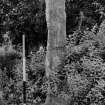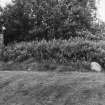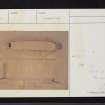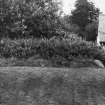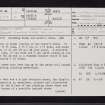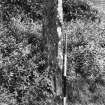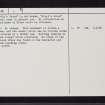Ardle's Grave
Mound (Period Unknown), Standing Stone (Period Unknown)
Site Name Ardle's Grave
Classification Mound (Period Unknown), Standing Stone (Period Unknown)
Alternative Name(s) Giant's Grave
Canmore ID 27581
Site Number NO06SE 2
NGR NO 06312 62788
Datum OSGB36 - NGR
Permalink http://canmore.org.uk/site/27581
- Council Perth And Kinross
- Parish Moulin
- Former Region Tayside
- Former District Perth And Kinross
- Former County Perthshire
Field Visit (9 April 1968)
NO06SE 2 0630 6279.
(NO 0630 6279) Standing Stone and Ardle's Grave (NR)
OS 25" map (1867)
Ardle's Grave is known locally as the Giant's Grave. It is a mound 19 ft long, 2 ft 6 ins to 3 ft wide, and about 20 ins high; it is set NW and SE (see plan). A monolith 5 ft 4 ins high, 16 ins wide and 6 ins thick stands at its NW end. At the SE end is a rounded boulder about 20 ins thick and nearly 2 ft broad.
(F R Coles 1908)
Many human bones have been dug up in the peaty soil around the grave during planting operations.
(J H Dixon 1925)
Situated on what was a slight morainic mound, the Giant's Grave is generally as described, planned and illustrated by Coles. On the E face of the standing stone there are very faint traces of a possible incised cross. The name "Ardle's Grave" is not known, "Giant's Grave" being the local name in general use. No information on the bones mentioned by Dixon could be obtained.
Visited by OS (RD) 9 April 1968
Field Visit (8 September 1980)
NO 0631 6279. No change. This monument is within a private garden, and the mound, which has no obvious stone content, is covered by a flower bed. Nothing remains to suggest a once larger cairn structure. No trace of the possible incised cross was found on the weathered and lichen-covered standing stone.
Surveyed at 1:2500.
Visited by OS (JRL) 8 September 1980
Field Visit (29 February 1988)
This stone stands in the garden of the lodge to Dirnanean. It measures 0.4m by 0.15m in section and is 1.7m in height. On the SE face of the stone, 0.75m below the top, there is a shallow rectangular rebate, 290mm long by 90mm wide, cut across the face from the NE side. The stone is set at the NW end of a low mound (now a flower bed) which measures 5.8m in length by 1.8m in breadth and 0.4m in height. At the SE end of the mound there is a rounded boulder about 0.7m wide and 0.5m high. The date and purpose of these remains are unknown but it is not likely to be a prehistoric standing stone.
Visited by RCAHMS (SPH) 29 February 1988.
RCAHMS 1990













